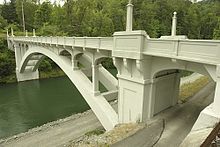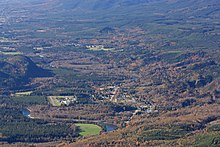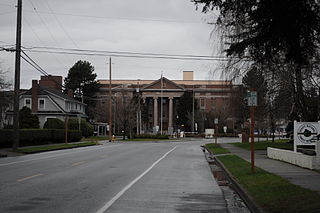
Skagit County is a county in the U.S. state of Washington. As of the 2020 census, the population was 129,523. The county seat and largest city is Mount Vernon. The county was formed in 1883 from Whatcom County and is named for the Skagit Indian tribe, which has been indigenous to the area prior to European-American settlement.

Chatom is a town in Washington County, Alabama, United States. It incorporated in 1949. Chatom is the county seat of Washington County, holding the distinction since 1907. The town's population was 1,288 At the 2010 census, up from 1,193 in 2000.

Bristol is a town in Washington Township, Elkhart County, Indiana, United States. The population was 1,602 at the 2010 census.

Speedway is a town in Wayne Township, Marion County, Indiana, United States. The population was 13,952 at the 2020 census, up from 11,812 in 2010. Speedway, which is an enclave of Indianapolis, is the home of the Indianapolis Motor Speedway.

Zachary is a city in East Baton Rouge Parish, Louisiana, United States. It lies 16 miles (26 km) north of the city of Baton Rouge, and had a population of 14,960 at the 2010 census, up from 11,275 in 2000. At the 2020 census, Zachary's population increased to 19,316.
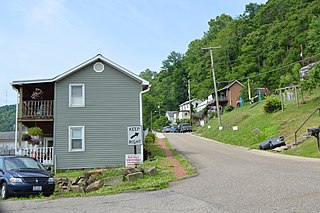
Clarington is a village in Monroe County, Ohio, United States, along the Ohio River. The population was 280 at the 2020 census.

Ritzville is a city in Adams County, Washington, United States. The population was 1,767 at the 2020 census. It is the county seat of Adams County. The city is part of the Othello, WA Micropolitan Area, which comprises all of Adams County, and is part of the larger Moses Lake-Othello, WA Combined Statistical Area.

West Richland is a city in Benton County, Washington. The population was 16,295 at the time of the 2020 census. The city is part of the Tri-Cities metropolitan area, whose principal cities are Richland, Kennewick, and Pasco.

Wilkeson is a town in Pierce County, Washington, United States. The population was 499 at the 2020 census.

Alger is a census-designated place (CDP) in Skagit County, Washington, United States. The population was 507 at the 2020 census. It is included in the Mount Vernon–Anacortes, Washington Metropolitan Statistical Area.

Burlington is a city in Skagit County, Washington, United States. Its population was recorded as 9,152 in the 2020 census. Burlington is located approximately halfway between Seattle and Vancouver, Canada. The city is included in the Mount Vernon–Anacortes, Washington Metropolitan Statistical Area.

Hamilton is a town in Skagit County, Washington, United States. The population was 299 at the 2020 census. It is included in the Mount Vernon-Anacortes, Washington Metropolitan Statistical Area.

La Conner is a town in Skagit County, Washington, United States with a population of 965 at the 2020 census. It is included in the Mount Vernon–Anacortes, Washington Metropolitan Statistical Area. The town hosts several events as part of the annual Skagit Valley Tulip Festival held in April.

Lyman is a town in Skagit County, Washington, United States. The population was 423 at the 2020 census. It is included in the Mount Vernon-Anacortes, Washington Metropolitan Statistical Area.

Marblemount is a census-designated place in Skagit County, Washington, United States. The population was 286 at the 2020 census. It is included in the Mount Vernon–Anacortes, Washington Metropolitan Statistical Area.
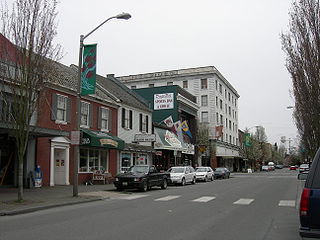
Mount Vernon is the most populous city in, and county seat of, Skagit County, Washington, United States. A central location in the Skagit River Valley, the city is located 51 miles south of the U.S.–Canada border and in between Vancouver, British Columbia and Seattle. The population was 35,219 at the 2020 census., making it the 35th most-populous city in Washington, with a larger 62,966 people living in its urban area. It is one of two principal cities of and included in the Mount Vernon-Anacortes, Washington Metropolitan Statistical Area, covering most of Skagit County.
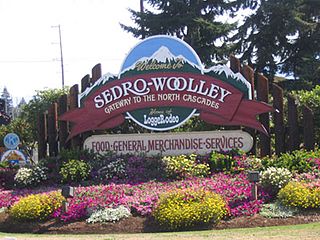
Sedro-Woolley is a city in Skagit County, Washington, United States. It is part of the Mount Vernon–Anacortes, Washington Metropolitan Statistical Area and had a population of 12,421 at the 2020 census. The city is home to North Cascades National Park.

Stevenson is a city in the Columbia River Gorge National Scenic Area along the Columbia River in Skamania County, Washington, United States. It is the county seat of Skamania County and home to the Skamania County Court House and Sheriff's Office. The population was 1,465 at the 2010 census, a 22% increase over 2000.

Waitsburg is a city in Walla Walla County, Washington, United States. The population was 1,166 at the 2020 census. Waitsburg has a unique city classification in Washington state, being the state's only city which still operates under its territorial charter.

Marlinton is a town in and the county seat of Pocahontas County, West Virginia, United States. The population was 998 at the 2020 census. Located along the Greenbrier River, it is known for its scenery.




